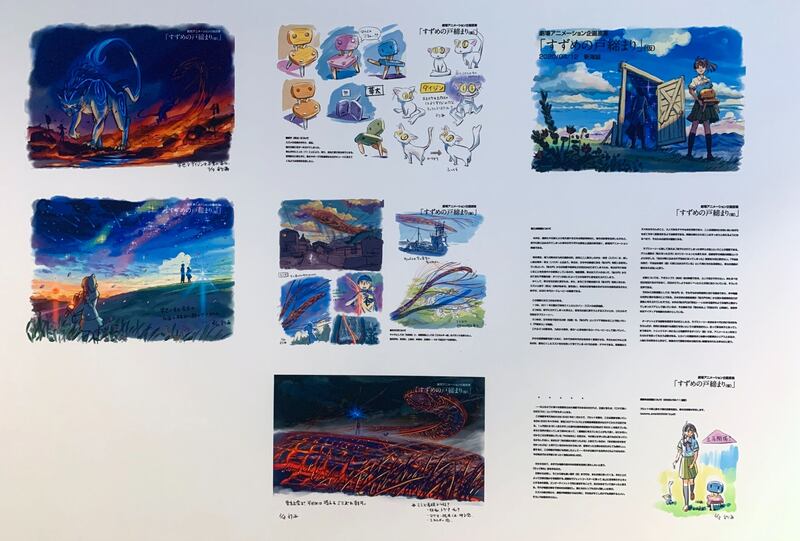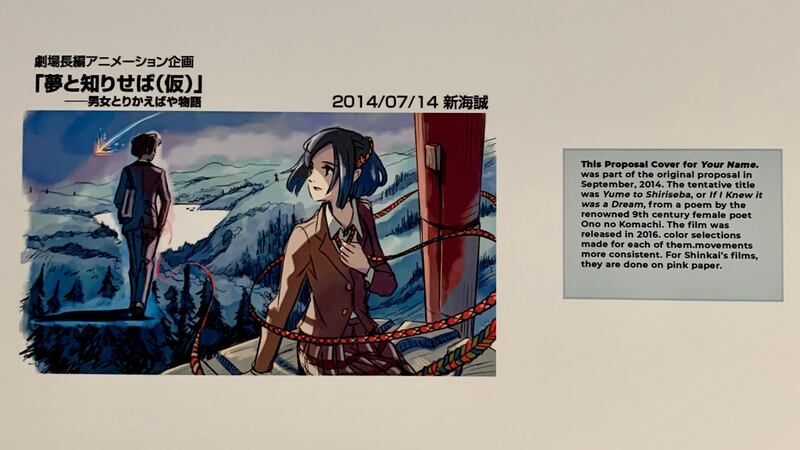As Oscar nominations are just around the corner, audiences should take note that 2023 featured some major contenders for Best Animated Feature. One notable release, yet possibly overlooked to U.S. audiences, was “Suzume,” a supernatural set to the backdrop of a real world event. Director Makoto Shinkai’s plot follows a high school-aged girl as she embarks on a storm-chasing roadtrip to save Japan from impending natural disasters visible only to a few.
For one day only on November 19, Los Angeles residents could also enjoy the Oscars experience alongside Shinkai’s works under the same roof at the Academy Museum of Motion Pictures. The exhibit displayed exclusive behind the scenes footage of his films’ production process such as photographs of intimate handwritten directors notes, storyboard panels, and culturally historical research.
Also included on these printed walls were explanations of anime as a unique production process and discussion of Japanese cultural nuances, making the experience enjoyable for longtime fans and newcomers. Throughout the day-long pop-up, three in-house screenings of his most recent, and most internationally renowned, films were offered: “Weathering With You,” “Suzume” and “Your Name.”

Visitors would quickly catch onto the pattern of protagonist duos pictured on movie posters and character concepts. Often leading with boy-meets-girl genres, Makoto Shinkai is known for traditional coming-of-age love premises set within near-miss apocalypse plots. However, more than an anime version of Nicholas Sparks, the Shinkai style cannot be separated from the setting of world-ending stakes.
Under an exhibit section discussing the vibrancy of his color palettes, museum guests can discern a strong sense of dynamic environments like towns engulfed in flames and hydroponic gardens in city rubble. There is no villain to fight Shinkai’s climactic scenes, as he instead draws on natural disasters, like the 2011 Great Earthquake in Japan.

According to the exhibition label that featured a handwritten welcome, portrait and a description, the 2011 Great East Japan Earthquake “profoundly affected his approach to his work.” While not personally affected by the earthquake, during a 2011 interview, Shinkai says that this was the year of his “real directorial debut” upon the release of a Ghibli-inspired adventure film, “Children Who Chase Lost Voices.”
Yet the budding director had not yet begun work exploring the genre he is known for today: natural disasters. That year, Shinkai took note of his somber surroundings and saw animation as a way to help people cope. And so, in 2016, Shinkai released a time-traveling tale of a deadly but mesmerizing comet in “Your Name,” landing a degree of commercial, critical and fan success so massive, it blew away his own personal expectations before they formed.

The three films screened throughout the day in the Academy Museum’s Dolby Theater have core sceneries of natural destruction on a grand scale, but also a clear plot that intimately follows a young protagonist exploring what is hidden behind their material world.
Romance is the most upfront discovery in all three big-hit films, which, even expected, is still beautifully scored by his longtime musical collaborator, Japanese rock band RADWIMPS. Original soundtracks flowed from the exhibit and screening room speakers during idle times, with mood-defining rhythms only film scores have.
Especially in Shinkai’s filmography, his sharp sense of art direction based on color is airtight aligned with RADWIMPS’ music production, making for a purposeful and potent emotional flow in any one given scene or sunset gaze.
If a visitor were to walk through the exhibit following the chronology of Shinkai’s filmography, they would see that the life-size movie poster for his latest film stands in contrast with the rest. Instead of facing each other or in another pose to suggest a romantic pairing, “Suzume” protagonists face forward towards the audience and step through a standalone weathered door frame in a field, suggesting the start of a supernatural adventure. Now forfeiting the traditional love story arcs, Shinkai has a new message for his audiences starting with “Suzume” and beyond.
He directly addresses the inevitable and increasing frequency of natural disasters in an interview with Ghibliotheque, listing COVID-19, the climate crisis, as well as war. He processes these and more through his young protagonists whose lives are inseparable from the anxiety before or aftermath of natural disasters.
A flood for one girl to fight in “Weathering With You,” or a splitting comet to convince evacuation from in “Your Name,” or a spontaneous earthquake to chase in “Suzume,” Shinkai asks his audiences: when you could stand to lose everything, what are the last few things you would take a risk for?
For twelve years, Shinkai waited to create “Suzume” after the earthquake. He waited out of consideration for the affected individuals but also says he wasn’t ready to face merging fantasy and reality that closely. The exhibit showcases his work with cultural historians to depict natural disasters and the beliefs that surround them.

Yet, the film sequences displayed on standing TVs at each corner result from Shinkai’s earnest creative decisions are treasured by many because they are inherently risky. For example, “Suzume” centers around a road trip across Japan, which follows a playlist of songs Shinkai methodically placed from a list of trending hits during 2011. Depicting a time of painful tragedy so explicitly in an entertainment form could be seen as controversial or disrespectful in Japanese culture. However, in the interview with Ghibliotheque, Shinkai explains that the playing of these “oldies” would show audiences that the story in the film is an extension of real life, thus the messaging about coping in the aftermath should be treated just as seriously.
Lastly, during the production of “Suzume,” which follows a high-school-aged girl on a storm-chasing supernatural mystery, Shinkai not only moved away from the boy-meets-girl genres, but pushes towards untraditional romances, “I think it would also work had [Suzume] been a boy or had she been non-binary,” he told Looper.
While future Shinkai protagonists could be flexible in gender or sexuality as compared to other anime films of a similar caliber, the director looks forward to future narratives about overcoming he continued in the Looper interview. Just like his beginnings as a one-man animation crew, Shinkai plans to continue to make short films and play with different film formats down the line. For now, he stands on equal ground with the anime directors that inspired him, and celebrates a streak of big-budget, hit feature films that altogether demonstrate animation’s technical innovation and loyalty to surreal stories.
